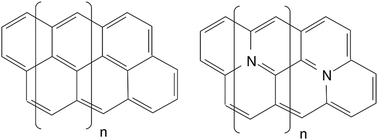peri-Acenoacene molecules: tuning of the singlet and triplet excitation energies by modifying their radical character†
Abstract
The energy difference between singlet and triplet excitons, or ΔEST, is a key parameter for novel light-emission mechanisms (i.e., TADF or thermally activated delayed fluorescence) or other photoactivated processes. We have studied a set of conjugated molecules (peri-acenoacenes and their heteroatom-doped analogues) to observe the evolution of their excited-state properties upon increasing the system size with and without substitution with a pair of N atoms. Since these molecules exhibit a (ground-state) diradicaloid character, together with marked correlation effects influencing the excited-states formed, we have applied a variety of theoretical methods (FT-DFT, TD-DFT, SF-TD-DFT, CIS, CIS(D), SCS-CC2, SA-CASSCF, and SC-NEVPT2) to bracket the accuracy of the results while concomitantly providing insights into electronic structure. The results show how this chemical strategy (N-doping) largely modifies not only the excited-state energies but also the oscillator strengths and the ΔEST values, constituting versatile platforms for fine-tuned photophysical applications.



 Please wait while we load your content...
Please wait while we load your content...